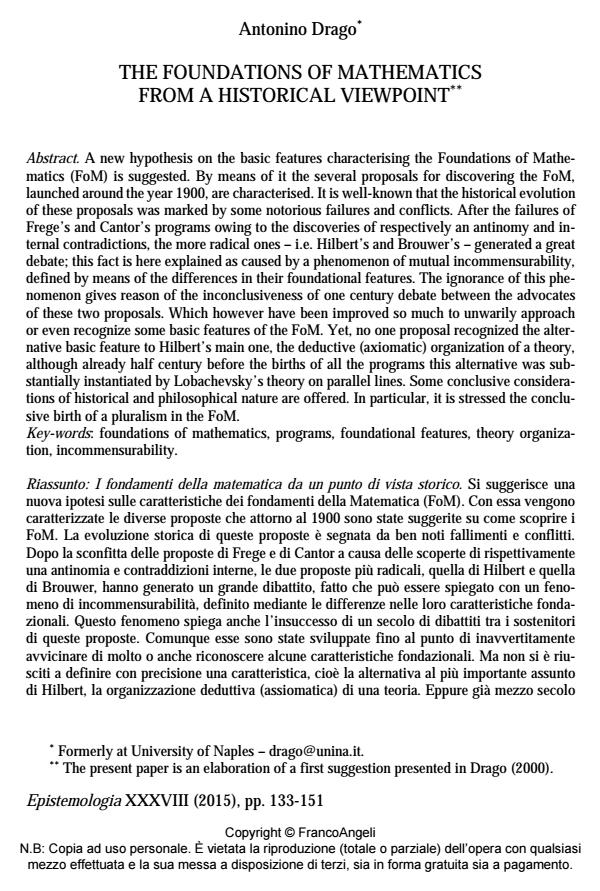The foundations of mathematics from a historical viewpoint
Journal title EPISTEMOLOGIA
Author/s Antonino Drago
Publishing Year 2015 Issue 2015/1
Language English Pages 19 P. 133-151 File size 98 KB
DOI 10.3280/EPIS2015-001009
DOI is like a bar code for intellectual property: to have more infomation
click here
Below, you can see the article first page
If you want to buy this article in PDF format, you can do it, following the instructions to buy download credits

FrancoAngeli is member of Publishers International Linking Association, Inc (PILA), a not-for-profit association which run the CrossRef service enabling links to and from online scholarly content.
A new hypothesis on the basic features characterising the Foundations of Mathematics (FoM) is suggested. By means of it the several proposals for discovering the FoM, launched around the year 1900, are characterised. It is well-known that the historical evolution of these proposals was marked by some notorious failures and conflicts. After the failures of Frege’s and Cantor’s programs owing to the discoveries of respectively an antinomy and internal contradictions, the more radical ones - i.e. Hilbert’s and Brouwer’s - generated a great debate; this fact is here explained as caused by a phenomenon of mutual incommensurability, defined by means of the differences in their foundational features. The ignorance of this phenomenon gives reason of the inconclusiveness of one century debate between the advocates of these two proposals. Which however have been improved so much to unwarily approach or even recognize some basic features of the FoM. Yet, no one proposal recognized the alternative basic feature to Hilbert’s main one, the deductive (axiomatic) organization of a theory, although already half century before the births of all the programs this alternative was substantially instantiated by Lobachevsky’s theory on parallel lines. Some conclusive considerations of historical and philosophical nature are offered. In particular, it is stressed the conclusive birth of a pluralism in the FoM.
Keywords: Foundations of mathematics, programs, foundational features, theory organization, incommensurability
- A new definition of reduction between two scientific theories: no reduction of chemistry to quantum mechanics Antonino Drago, in Foundations of Chemistry /2020 pp.421
DOI: 10.1007/s10698-020-09377-1
Antonino Drago, The foundations of mathematics from a historical viewpoint in "EPISTEMOLOGIA" 1/2015, pp 133-151, DOI: 10.3280/EPIS2015-001009